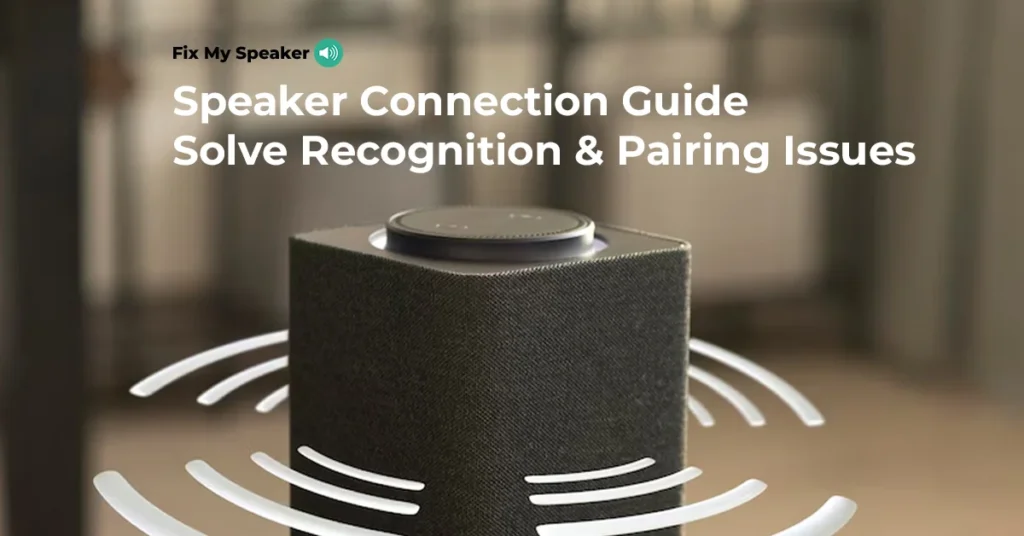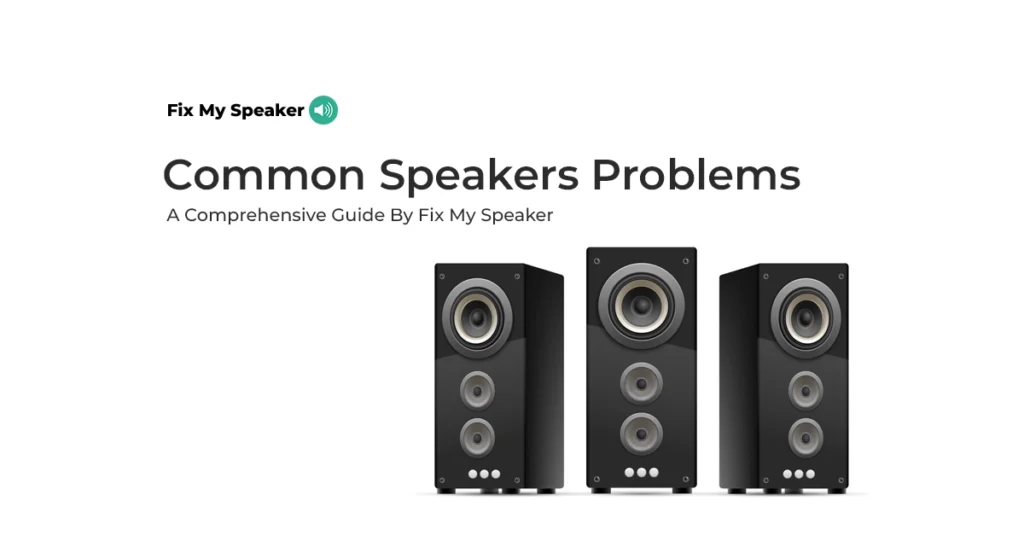Whether you’re listening to music, watching movies, or participating in video calls, reliable speaker connectivity is essential for seamless audio output. However, many users encounter connectivity and recognition issues that can significantly disrupt their audio experience.
This comprehensive guide aims to address common speaker connectivity problems and provide practical solutions to ensure your speakers function optimally across different devices and platforms.
Why Your Speaker Is Not Recognized by Devices
Speaker recognition issues can be frustrating, often leaving users without audio output when they need it most. Understanding the root causes of these problems is the first step towards resolving them effectively.
Common Reasons for Speaker Recognition Problems:
- Outdated or corrupted device drivers
- Incompatible audio formats or codecs
- Hardware conflicts with other connected devices
- Operating system bugs or glitches
- Physical connection issues (for wired speakers)
- Bluetooth pairing problems (for wireless speakers)
How to Check for Driver Issues and Compatibility:
- Open Device Manager (Windows) or System Information (Mac).
- Locate the “Sound, video and game controllers” section.
- Check if your speakers are listed and if there are any warning icons.
- Right-click on the speaker device and select “Update driver” if available.
- For Mac users, check for software updates in the App Store.
Solutions for Recognition Problems:
- Update Audio Drivers:
- Visit the manufacturer’s website to download the latest drivers.
- Use built-in update tools like Windows Update or Mac’s Software Update.
- Consider using driver update software for automatic updates.
- Check Physical Connections:
- Ensure all cables are securely connected.
- Try different USB ports or audio jacks if applicable.
- Test the speakers on another device to rule out hardware issues.
- Troubleshoot Bluetooth Connections:
- Remove the speaker from your device’s Bluetooth list and re-pair.
- Ensure the speaker is in pairing mode when attempting to connect.
- Update your device’s Bluetooth drivers or firmware.
- Perform System Checks:
- Run the Windows audio troubleshooter or Mac’s Audio MIDI Setup utility.
- Check for pending system updates that might resolve audio issues.
- Restart your computer to clear any temporary glitches.
- Verify Audio Settings:
- Ensure the correct audio output device is selected in your system settings.
- Check volume levels and make sure the audio isn’t muted.
- Disable any audio enhancements that might be causing conflicts.
By systematically working through these steps, you can identify and resolve most speaker recognition issues. Remember to restart your device after making changes to ensure they take effect.
Resolving Speaker Connectivity Issues Across Different Platforms
Speaker connectivity problems can vary depending on the platform and connection type you’re using. Here’s a comprehensive guide to troubleshooting connectivity issues across various platforms:
Windows:
- Check Audio Settings:
- Right-click the speaker icon in the taskbar and select “Open Sound settings”.
- Ensure the correct output device is selected under “Choose your output device”.
- Run the Audio Troubleshooter:
- Go to Settings > System > Sound > Troubleshoot.
- Follow the on-screen instructions to identify and fix issues.
- Update Audio Drivers:
- Open Device Manager and expand “Sound, video and game controllers”.
- Right-click your audio device and select “Update driver”.
- Disable Audio Enhancements:
- Right-click the speaker icon and select “Open Sound settings”.
- Click “Device properties” under the output device.
- Uncheck “Enable audio enhancements” if available.
Mac:
- Check Sound Preferences:
- Go to Apple menu > System Preferences > Sound.
- Select the “Output” tab and choose the correct audio device.
- Reset the Audio System:
- Open Terminal and type: sudo killall coreaudiod
- Press Enter and enter your admin password if prompted.
- Create a New User Account:
- If issues persist, create a new user account to determine if it’s a system-wide problem.
Android:
- Check Volume Settings:
- Use the volume buttons to ensure media volume is turned up.
- Tap the dropdown arrow in the volume slider to check other volume settings.
- Clear Bluetooth Cache:
- Go to Settings > Apps > See all apps > Bluetooth > Storage & cache.
- Tap “Clear cache” and “Clear storage”.
- Reset Network Settings:
- Go to Settings > System > Reset options > Reset Wi-Fi, mobile & Bluetooth.
- Note: This will remove all saved Wi-Fi networks and paired Bluetooth devices.
iOS:
- Check Bluetooth Settings:
- Go to Settings > Bluetooth and ensure it’s turned on.
- If your speaker is listed, tap the “i” icon and select “Forget This Device”, then re-pair.
- Reset Network Settings:
- Go to Settings > General > Reset > Reset Network Settings.
- Note: This will remove all saved Wi-Fi networks and paired Bluetooth devices.
- Update iOS:
- Go to Settings > General > Software Update to check for and install any available updates.
Importance of Firmware Updates and Software Checks:
Keeping your devices and speakers up-to-date is crucial for maintaining optimal connectivity. Regular firmware updates can:
- Improve compatibility with newer devices and operating systems
- Enhance Bluetooth connectivity and range
- Fix known bugs and issues
- Add new features and functionality
To check for firmware updates:
- Visit the manufacturer’s website and look for a “Support” or “Downloads” section.
- Enter your speaker’s model number to find available updates.
- Follow the manufacturer’s instructions for updating firmware, which may involve connecting the speaker to a computer or using a mobile app.
- Ensuring Stable Connections in Wireless Speakers
Wireless speakers offer convenience and flexibility, but they can sometimes suffer from connectivity issues. Understanding the factors that affect wireless connectivity and implementing best practices can help maintain a stable connection.
Factors Affecting Wireless Connectivity:
- Distance from the audio source
- Physical obstacles (walls, furniture, etc.)
- Interference from other electronic devices
- Network congestion (for Wi-Fi speakers)
- Battery level of the speaker
- Environmental factors (temperature, humidity)
Tips for Maintaining a Stable Wireless Connection:
- Optimal Placement:
- Keep the speaker within the recommended range of the audio source (usually 30 feet for Bluetooth).
- Minimize physical obstacles between the speaker and the source device.
- Elevate the speaker off the ground to improve signal reception.
- Reduce Interference:
- Keep the speaker away from other electronic devices, especially those that emit wireless signals.
- For Wi-Fi speakers, consider using the 5GHz band if available, as it’s less congested.
- Turn off unnecessary wireless devices in the vicinity.
- Maintain Power:
- Keep wireless speakers charged or connected to power for optimal performance.
- Some speakers may reduce wireless range when battery levels are low.
- Regular Resets:
- Periodically turn your wireless speaker off and on to refresh the connection.
- For persistent issues, perform a factory reset (consult your speaker’s manual for instructions).
- Update Firmware:
- Regularly check for and install firmware updates for your wireless speaker.
- Updates often include improvements to wireless connectivity and stability.
- Network Optimization (for Wi-Fi speakers):
- Ensure your Wi-Fi network is stable and has a strong signal where the speaker is placed.
- Consider using a Wi-Fi extender if the speaker is far from your router.
- Bluetooth Pairing Best Practices:
- Keep your speaker in pairing mode only when actively trying to connect.
- Forget and re-pair the speaker occasionally to refresh the connection.
- Environmental Considerations:
- Be aware that extreme temperatures or humidity can affect wireless performance.
- If using outdoors, ensure the speaker is rated for outdoor use.
| Issue | Possible Cause | Solution |
| Frequent disconnections | Distance or obstacles | Move speaker closer to source, remove obstacles |
| Intermittent audio | Interference | Move away from other electronic devices |
| Cannot connect | Pairing issues | Forget device and re-pair, update firmware |
| Poor sound quality | Network congestion | Switch to 5GHz Wi-Fi or move closer to router |
| Connection drops at specific times | Scheduled network changes | Check router settings, disable auto-channel switching |
By implementing these tips and understanding the factors that affect wireless connectivity, you can significantly improve the stability and reliability of your wireless speaker connections.
Take Away
Resolving speaker connectivity and recognition issues requires a systematic approach and an understanding of the various factors that can affect audio performance across different platforms. By following the troubleshooting steps outlined in this guide, you can address most common connectivity problems and ensure your speakers function optimally.
Remember these key points for maintaining consistent speaker performance:
- Regularly update device drivers and speaker firmware
- Keep your operating system and apps up-to-date
- Periodically check and clean physical connections
- Be mindful of your wireless environment and potential sources of interference
- Familiarize yourself with your speaker’s specific features and troubleshooting steps


